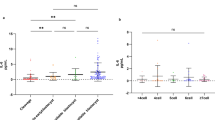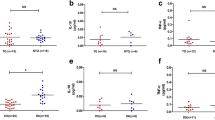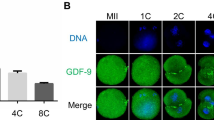Abstract
Purpose
To determine the association between ammonium concentration in culture medium and blastocyst development and to assess the influence of increased ammonium concentration on the expression of Bax, Bcl-2 and Oct4.
Methods
A total of 254 cleavage-stage embryos were individually cultured in 30μL G2-plus medium on Day 3, and then culture media samples were collected on Day 5 for ammonium concentration determination immediately after evaluating the embryos morphology. Poor-quality blastocysts (combined score of CC) were used for gene expression analysis. The blastocyst formation rate, good-quality blastocyst rate and relative expression levels of Bax, Bcl-2 and Oct4 were analyzed.
Results
Based on receiver operating characteristic curve, the cutoff value of ammonium concentration produced by embryos was 16.07 μmol/L (AUC = 0.722, 95% CI 0.637–0.807; P = 0.000), so all embryos were assigned to two groups according to the cutoff value: normal group (< 16.07 μmol/L) and increased group (≥ 16.07 μmol/L). There was a significant difference in blastocyst formation rate (80.5% vs 59.0%, P < 0.01) between normal group and increased group, as well as for good-quality blastocyst rate (21.0% vs 3.4%, P < 0.01). A significantly higher expression level of Bax (P < 0.05) and considerably lower expression level of Oct4 (P < 0.01) were observed in increased group compared to normal group.
Conclusion
Our data demonstrated for the first time that increased ammonium concentration in culture medium may promote cellular apoptosis and negatively affect pluripotency of human blastocyst.



Similar content being viewed by others
References
Card DA, Hebbar PB, Li L, Trotter KW, Komatsu Y, Mishina Y, Archer TK (2008) Oct4/Sox2-regulated miR-302 targets cyclin D1 in human embryonic stem cells. Mol Cell Biol 28:6426–6438
Gardner DK, Hamilton R, Mccallie B, Schoolcraft WB, Katz-Jaffe MG (2013) Human and mouse embryonic development, metabolism and gene expression are altered by an ammonium gradient in vitro. Reproduction 146:49–61
Gardner DK, Lane M (1993) Amino acids and ammonium regulate mouse embryo development in culture. Biol Reprod 48:377
Gardner DK, Lane M (2003) Towards a single embryo transfer. Reprod Biomed Online 6:470–481
Gardner DK, Schoolcraft WB (1999) In vitro culture of human blastocyst. Reprod certainty infertility Genet beyond towards 11:307–311
Gross A, Mcdonnell JM, Korsmeyer SJ (1999) BCL-2 family members and the mitochondria in apoptosis. Gen Develop. https://doi.org/10.1101/gad.13.15.1899
Kleijkers SH, van Montfoort AP, Bekers O, Coonen E, Derhaag JG, Evers JL, Dumoulin JC (2016) Ammonium accumulation in commercially available embryo culture media and protein supplements during storage at 2–8 °C and during incubation at 37 °C. Hum Reprod 31(6):1192–1199
Hammon DS, Wang S, Holyoak GR (2000) Effects of ammonia during different stages of culture on development of in vitro produced bovine embryos. Anim Reprod Sci 59:23–30
Lane M (1994) Increase in postimplantation development of cultured mouse embryos by amino acids and induction of fetal retardation and exencephaly by ammonium ions. J Reprod Fertil 102:305–312
Medicine ASIR, Embryology ESIG (2011) The Istanbul consensus workshop on embryo assessment: proceedings of an expert meeting. Hum Reprod 22:632–646
Michelle L, Gardner DK (2003) Ammonium induces aberrant blastocyst differentiation, metabolism, pH regulation, gene expression and subsequently alters fetal development in the mouse. Biol Reprod 69:1109–1117
Niwa H (2007) How is pluripotency determined and maintained? Development 134:635–646
Niwa H, Miyazaki J-I, Smith AG (2000) Quantitative expression of Oct-3/4 defines differentiation, dedifferentiation or self-renewal of ES cells. Nat Genet 24:372–376
Virant-Klun I, Tomaževič T, Vrtačnik-Bokal E, Vogler A, Krsnik M, Meden-Vrtovec H (2006) Increased ammonium in culture medium reduces the development of human embryos to the blastocyst stage. Fertil Steril 85:526–528
Youle RJ, Strasser A (2008) The BCL-2 protein family: opposing activities that mediate cell death. Nat Rev Mol Cell Biol 9:47–59
Yuan Y, Krisher RL (2010) Effect of ammonium during in vitro maturation on oocyte nuclear maturation and subsequent embryonic development in pigs. Anim Reprod Sci 117:302–307
Zhao H, Ji Q, Zhao G, Song Z, Du B, Nie Y, Chen Y, Cong P (2014) Damage of zona pellucida reduces the developmental potential and quality of porcine circovirus type 2–infected oocytes after parthenogenetic activation. Theriogenology 82:790–799
Acknowledgements
The authors thank all the patients who enrolled in the study, the clinical staff, and embryologist.
Funding
The author declare that Qingxue Zhang: MerckSerono China Research Fund for Fertility Experts, Sun Yat-sen University Clinical Research 5010 Program.
Author information
Authors and Affiliations
Contributions
HZ, QQ, and SO were responsible for the study design, ammonium concentration detection, molecular experimental procedures, acquisition of data, and the original version of the article. HL and WW recruited participants. QZ supervised the study, evaluated the clinical application, and edited the final manuscript. All co-authors read and approved the final version of the article.
Corresponding author
Ethics declarations
Conflict of interest
The authors declare no conflict of interest.
Additional information
Publisher's Note
Springer Nature remains neutral with regard to jurisdictional claims in published maps and institutional affiliations.
Rights and permissions
Springer Nature or its licensor (e.g. a society or other partner) holds exclusive rights to this article under a publishing agreement with the author(s) or other rightsholder(s); author self-archiving of the accepted manuscript version of this article is solely governed by the terms of such publishing agreement and applicable law.
About this article
Cite this article
Zhao, H., Qiu, Q., Ou, S. et al. Increased ammonium in culture medium may promote cellular apoptosis and negatively affect pluripotency of human blastocysts. Arch Gynecol Obstet 307, 619–624 (2023). https://doi.org/10.1007/s00404-022-06844-2
Received:
Accepted:
Published:
Issue Date:
DOI: https://doi.org/10.1007/s00404-022-06844-2




